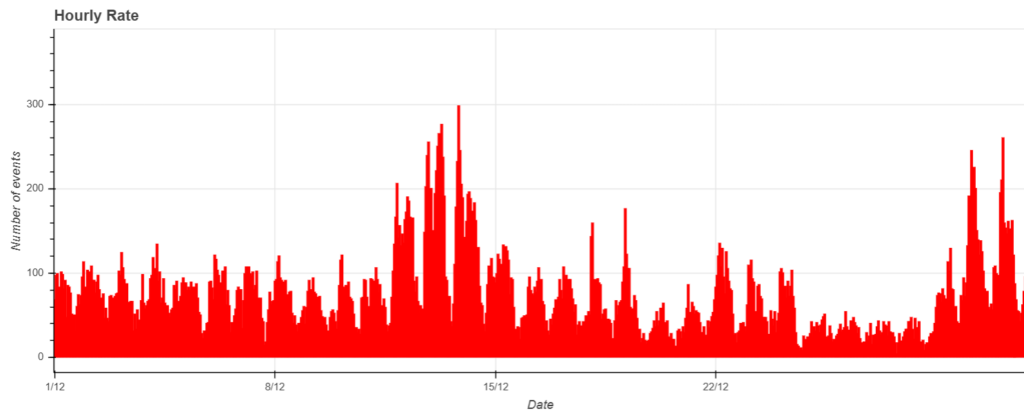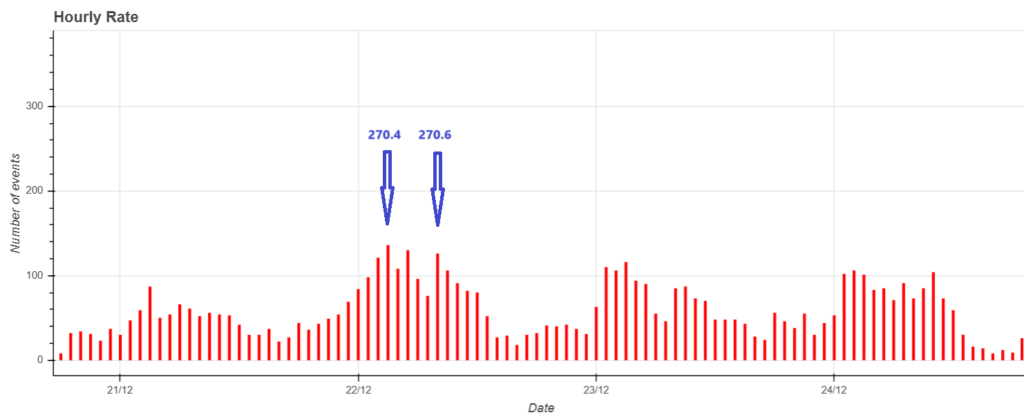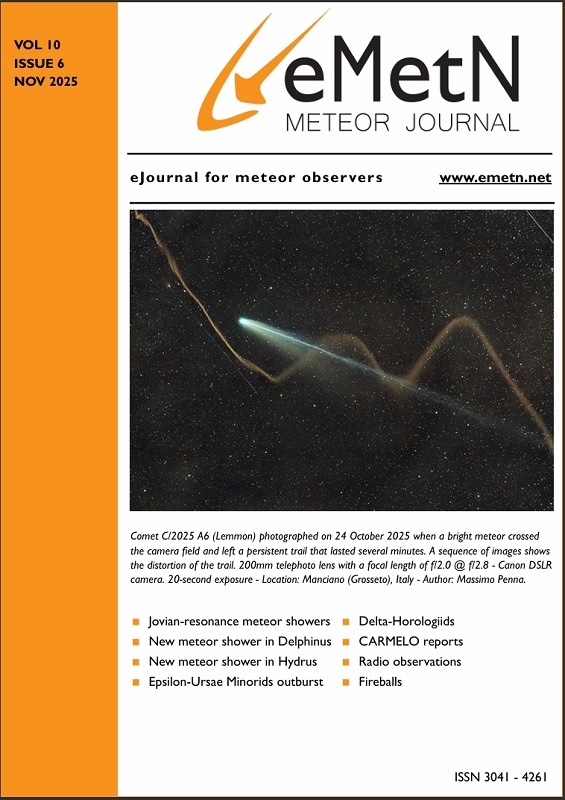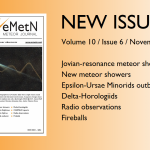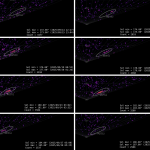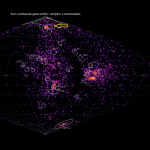Mariasole Maglione (Gruppo Astrofili Vicentini)
Lorenzo Barbieri (CARMELO network and AAB: Associazione Astrofili Bolognesi)
Introduction
December is the month of the Geminids (GEM), a very unusual shower because it originated not from a comet but from an asteroid, 3200 Phaeton. The peak of the Geminids was recorded by the CARMELO network on the night of December 13-14. Minor showers were also present, with a slight increase in activity between Dec. 22 and 24 and the peak of the Ursids.
Methods
The CARMELO network consists of SDR radio receivers. In them, a microprocessor (Raspberry) performs three functions simultaneously:
- By driving a dongle, it tunes the frequency on which the transmitter transmits and tunes like a radio, samples the radio signal and through the FFT (Fast Fourier Transform) measures frequency and received power.
- By analyzing the received data for each packet, it detects meteoric echoes and discards false positives and interference.
- It compiles a file containing the event log and sends it to a server.
The data are all generated by the same standard, and are therefore homogeneous and comparable. A single receiver can be assembled with a few devices whose total current cost is about 210 euros.
To participate in the network read the instructions on this page.
December data
In the plots that follow, all available at this page, the abscissae represent time, which is expressed in UT (Universal Time) or in solar longitude (Solar Long), and the ordinates represent the hourly rate, calculated as the total number of events recorded by the network in an hour divided by the number of operating receivers.
In fig.1, the trend of signals detected by the receivers for the month of December.
Geminids
December’s star is the Geminid meteor shower (GEM), a fast-moving shower that is likely to disappear completely in less than a hundred years.
Geminids represent a unique case among meteor showers: their origin is not linked to a comet, but to an asteroid, 3200 Phaethon (1). Discovered in 1983 with the Infrared Astronomical Satellite (IRAS), 3200 Phaethon is an Apollo-type asteroid with a highly elliptical orbit, which intersects those of Mars, Earth, Venus and Mercury and brings it very close to the Sun, closer than any other known asteroid. This close passage generates extremely high temperatures, capable of exceeding 750°C, enough to cause sublimation of some surface materials and the release of debris. This debris constitutes the very material that originates the Geminids.
Models suggest that debris is produced in significant quantities each time the asteroid passes close to the Sun, and is distributed along its orbit in a compact, well-defined trail.
Geminids are usually active from Dec. 2 to Dec. 19. In recent years, the ZHR (Zenithal Hourly Rate) has remained constant with 120-150 meteors recorded per hour and a peak of activity between December 13 and 14.
The radiant of the shower, or the point in the sky where the meteors appear to come from, is located in the Gemini constellation, near the bright star Castor. For skies in the Northern Hemisphere, it rises around 18 UT and sets around 9 UT.
This year, the presence of the nearly full Moon (and bad weather, in Italy) hampered visual observation. As for radio observation, CARMELO network receivers recorded a high rate on both the night of December 13 and the night between December 13 and 14, with a maximum peak in the hourly rate of 299 events at 20:00 UT on the 13th, at solar longitude 261.9° (fig.2).
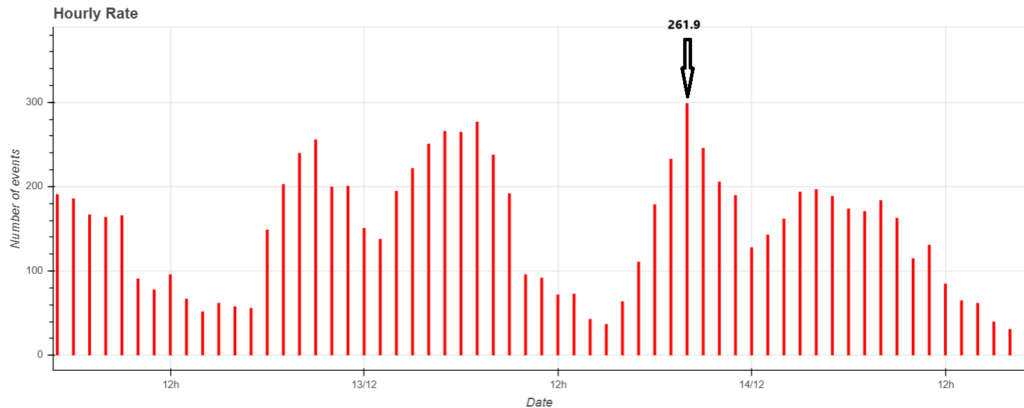
Fig.2: Period of maximum activity of the Geminid shower between Dec. 13 and Dec. 14 and maximum peak at solar longitude 261.9°.
Ursids
Ursids (URS) are another December meteor shower, active annually between the 17th and 26th of the month and much less rich than the Geminids. Ursids are produced by debris left behind by comet 8P/Tuttle, a periodic comet that crosses the Solar System with an orbit of about 13.6 years.
The radiant is located in the Ursa Minor constellation, near the star Beta Ursae Minoris (Kochab).
Ursids usually reach their peak activity between December 22 and 23, with an average frequency of 5-10 visible meteors per hour under normal conditions, but with occasional outbursts that can increase the number of meteors.
Also in 2024, activity increased slightly between Dec. 22 and Dec. 24 (fig. 3), particularly between solar longitudes 270.4° and 270.6°.
Peter Jenniskens in 2006 (2) analyzed the behavior of Ursids, identifying a main strand of the shower that initially formed near the progenitor body, comet 8P/Tuttle. Jenniskens showed that the outburst, or peak of meteor activity, coincides with the time when the progenitor body is at aphelion (the farthest point from the Sun along its orbit). Through mathematical modeling, the author showed that Ursid meteoroids in fact tend to remain concentrated in a specific orbital resonance, with a ratio of 15/13. This resonance would be influenced by proximity to the 1/1 resonance with Jupiter.
Jenniskens in particular plotted the meteoroid distribution and shower passes year by year, covering the period from 1994 to 2004. In addition, he provided predictions for future events.
An interesting point to note is that our data turns out to be in excellent agreement with the predictions made by Jenniskens.
CARMELO update
As can be seen from the graph in fig. 1 showing the trend for the month of December, the hourly rate of events increased in the last days of the month.
The reason for this increase is related to a recently performed update of CARMELO’s software. With this new version, from now on CARMELO will record the radio power of each meteor echo and no longer the signal-to-noise ratio (SNR) value.
In addition, the bandwidth has been narrowed to 20 kHz, and the devices have been equipped with a new and more effective filter on false positives.
The CARMELO network
The network currently consists of 14 receivers, 13 of which are operational, located in Italy, the UK, Croatia and the USA. The European receivers are tuned to the Graves radar station frequency in France, which is 143.050 MHz. Participating in the network are:
- Lorenzo Barbieri, Budrio (BO) ITA
- Associazione Astrofili Bolognesi, Bologna ITA
- Associazione Astrofili Bolognesi, Medelana (BO) ITA
- Paolo Fontana, Castenaso (BO) ITA
- Paolo Fontana, Belluno (BL) ITA
- Associazione Astrofili Pisani, Orciatico (PI) ITA
- Gruppo Astrofili Persicetani, San Giovanni in Persiceto (BO) ITA
- Roberto Nesci, Foligno (PG) ITA
- MarSEC, Marana di Crespadoro (VI) ITA
- Gruppo Astrofili Vicentini, Arcugnano (VI) ITA
- Associazione Ravennate Astrofili Theyta, Ravenna (RA) ITA
- Akademsko Astronomsko Društvo, Rijeka CRO
- Mike German a Hayfield, Derbyshire UK
- Mike Otte, Pearl City, Illinois USA
The authors’ hope is that the network can expand both quantitatively and geographically, thus allowing the production of better quality data.
References
(1) Peter Jenniskens et al. (2006): “Meteor showers and their parent comets”. Cambridge University Press, 397-422
(2) Peter Jenniskens et al. (2006): “Meteor showers and their parent comets”. Cambridge University Press, 263-265

